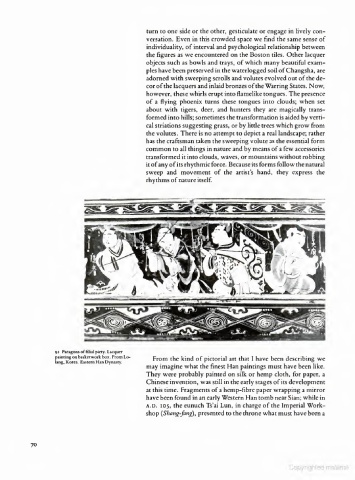Page 90 - The Arts of China, By Michael Sullivan Good Book
P. 90
turn to one side or the other, gesticulate or engage in lively con-
versation. Even in this crowded space we find the same sense of
individuality, of interval and psychological relationship between
the figures as we encountered on the Boston tiles. Other lacquer
objects such as bowls and trays, of which many beautiful exam-
ples have been preserved in the waterlogged soil of Changsha, are
adorned with sweeping scrolls and volutes evolved out of the de-
cor of the lacquers and inlaid bronzes of the Warring States. Now,
however, these whirls erupt into flamelikc tongues. The presence
of a flying phoenix turns these tongues into clouds; when set
about with tigers, deer, and hunters they are magically trans-
formed into hills; sometimes the transformation is aided by verti-
cal striations suggesting grass, or by little trees which grow from
the volutes. There is no attempt to depict a real landscape; rather
has the craftsman taken the sweeping volute as the essential form
common to all things in nature and by means of a few accessories
transformed it into clouds, waves, or mountains without robbing
it of any of its rhythmic force. Because its forms follow the natural
sweep and movement of the artist's hand, they express the
rhythms of nature itself.
92 Paragons of filial piety. Lacquer
P«nrin g «ir«sketworkbox. From Lo- From the kind of p i ctorial art that I have been describing we
lang. Korea. Eastern Han Dynasty. T 1111
may imagine what the finest Han paintings must have been like.
They were probably painted on silk or hemp cloth, for paper, a
Chinese invention, was still in the early stages of its development
at this time. Fragments of a hemp-fibre paper wrapping a mirror
have been found in an early Western Han tomb near Sian; while in
a.d. 105, the eunuch Ts'ai Lun, in charge of the Imperial Work-
shop (Shang-fang), presented to the throne what must have been a

